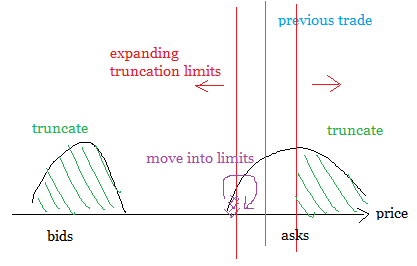wow, discontinuity

So they say $39 is a glitch. But even $56 (the “actual price”) isn’t much of a real price. Look at the discontinuity! Now what economic or financial purpose did that serve?
On other exchanges Thursday afternoon, shares of Procter & Gamble had tumbled as much as $22.79, or 37%, at one point, to $39.37. But because the stock fell below a key circuit-breaker level called the “liquidity replenishment point” or LRP on NYSE, the exchange stopped its own electronic trading in the stock briefly to go into “slow” mode. Under that mode, the designated market makers on the NYSE floor are given an opportunity to come in on the other side of an order at a price they have time to think about.
This just shouldn’t happen. I’ve said this before: why not put some damping? Low-pass filter the thing to human time-scales (anything shorter is useless noise). Only allow the orderbook to be filled away from the last trade price after time has passed, proportional to distance away, like this:

 Comments(2)
Comments(2)
http://finance.yahoo.com/news/SEC-pushes-tighter-rb-2352422438.html?x=0&sec=topStories&pos=main&asset=&ccode=
“Aiming to avoid a repeat of the stock market’s ‘flash crash’ on May 6, the U.S. Securities and Exchange Commission and big exchanges are eyeing minimum obligations for market-making firms that would force them to submit quotes that are less than 10 percent away from a stock’s current price, four sources said.”
Finally, but still flawed. The bands must expand with time since last trade, or there would be deadlocks on stale prices.
[...] As alluded to here and here, could damping of price and flow mechanisms in markets create more stability? And at what [...]